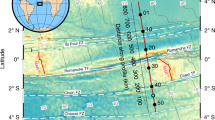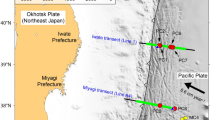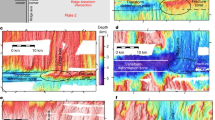Abstract
The dehydration of subducting oceanic crust and upper mantle has been inferred both to promote the partial melting leading to arc magmatism and to induce intraslab intermediate-depth earthquakes, at depths of 50–300 km. Yet there is still no consensus about how slab hydration occurs or where and how much chemically bound water is stored within the crust and mantle of the incoming plate. Here we document that bending-related faulting of the incoming plate at the Middle America trench creates a pervasive tectonic fabric that cuts across the crust, penetrating deep into the mantle. Faulting is active across the entire ocean trench slope, promoting hydration of the cold crust and upper mantle surrounding these deep active faults. The along-strike length and depth of penetration of these faults are also similar to the dimensions of the rupture area of intermediate-depth earthquakes.
This is a preview of subscription content, access via your institution
Access options
Subscribe to this journal
Receive 51 print issues and online access
$199.00 per year
only $3.90 per issue
Buy this article
- Purchase on Springer Link
- Instant access to full article PDF
Prices may be subject to local taxes which are calculated during checkout




Similar content being viewed by others
References
Savage, J. C. The mechanics of deep-focus faulting. Tectonophysics 8, 115–127 (1969)
Frohlich, C. The nature of deep-focus earthquakes. Annu. Rev. Earth Planet. Sci. 17, 227–254 (1989)
Raleigh, C. B. & Paterson, M. S. Experimental deformation of serpentinite and its tectonic implications. J. Geophys. Res. 70, 3965–3985 (1965)
Kirby, S., Engdahl, E. R. & Denlinger, R. in Subduction: Top to Bottom (eds Bebout, G. E., Scholl, D., Kirby, S. H. & Platt, J. P.) 195–214 (Geophysical Monograph 96, American Geophysical Union, Washington, 1996)
Tibi, R., Bock, G. & Estabrook, C. H. Seismic body wave constraint on mechanisms of intermediate-depth earthquakes. J. Geophys. Res. 107, 101029/2001JB000361 (2002)
Meade, C. & Jeanloz, R. Deep focus earthquakes and recycling of water into the Earth's mantle. Science 252, 68–72 (1991)
Peacock, S. Are the lower planes of double seismic zones caused by serpentine dyhydration in subducting oceanic mantle? Geology 29, 299–302 (2001)
Jiao, W., Silver, P. G., Fei, Y. & Prewitt, C. T. Do intermediate- and deep-focus earthquakes occur on preexisting weak zones? An examination of the Tonga subduction zone. J. Geophys. Res. 105, 28125–28138 (2000)
Gill, J. Orogenic Andesites and Plate Tectonics (Springer, New, 1981)
Ulmer, P. & Trommsdorff, V. Serpentine stability to mantle depths and subduction-related magmatism. Science 268, 858–861 (1995)
Ernst, W. G. Hornblende. The continent maker—Evolution of H2O during circum-Pacific subduction versus continental collision. Geology 27, 675–678 (1999)
Peacock, S. Fluid processes in subduction zones. Science 248, 329–337 (1990)
Moore, J. C. & Vrolijk, P. Fluids in accretionary prisms. Rev. Geophys. 30, 113–135 (1992)
Seno, T. & Yamanaka, Y. in Subduction: Top to Bottom (eds Bebout, G. E., Scholl, D., Kirby, S. H. & Platt, J. P.) 347–355 (Geophysical Monograph 96, American Geophysical Union, Washington, 1996)
Christensen, D. H. & Ruff, L. Seismic coupling and outer rise earthquakes. J. Geophys. Res. 93, 13421–13444 (1988)
Hasegawa, A., Horiuchi, S. & Umino, N. Seismic structure of the northeastern Japan convergent margin: A synthesis. J. Geophys. Res. 99, 22295–22311 (1994)
Barckhausen, G. A., Ranero, C. R., von Huene, R., Cande, S. & Roeser, H. Revised tectonic boundaries in the Cocos Plate off Costa Rica: Implications for the segmentation of the convergent margin and for plate tectonic models. J. Geophys. Res. 106, 19207–19220 (2001)
Protti, M., Guendel, F. & McNally, K. Correlation between the age of the subducting Cocos plate and the geometry of the Wadati-Benioff zone under Nicaragua and Costa Rica. Geol. Soc. Am. (Spec. Pap.) 295, 309–326 (1995)
Li, C. Forearc structures and tectonics in the Southern Peru—Northern Chile continental margin. Mar. Geophys. Res. 17, 97–113 (1995)
von Huene, R. et al. Tectonic control of the subducting Juan Fernández Ridge on the Andean margin near Valparaiso, Chile. Tectonics 16, 474–488 (1997)
von Huene, R. & Ranero, C. R. Subduction erosion and basal friction along the sediment starved convergent margin off Antofagasta Chile. J. Geophys. Res. 108(2079), 101029/2001JB001569 (2003)
Kobayashi, K., Nakanishi, M., Tamaki, K. & Ogawa, Y. Outer slope faulting associated with the western Kuril and Japan trenches. Geophys. J. Int. 134, 356–372 (1998)
Masson, D. G. Fault patterns at outer trench walls. Mar. Geophys. Res. 13, 209–225 (1991)
Ranero, C. R., Reston, T. J., Belykh, I. & Gnibidenko, H. Reflective oceanic crust formed at a fast-spreading center in the Pacific. Geology 25, 499–502 (1997)
Barth, G. A. & Mutter, J. C. Variability in oceanic crustal thickness and structure: Multichannel seismic reflection results from the northern East Pacific Rise. J. Geophys. Res. 101, 17951–17975 (1996)
Detrick, R. S. et al. Seismic structure of the southern East Pacific Rise. Science 259, 499–503 (1993)
Carbotte, S. M., Solomon, A. & Ponce-Correa, G. Evaluation of morphological indicators of magma supply and segmentation from a seismic reflection study of the East Pacific Rise 15 30'-17 N. J. Geophys. Res. 105, 2737–2759 (2000)
Phipps Morgan, J., Harding, A., Orcutt, J., Kent, G. & Chen, Y. J. in Magmatic Systems (ed. Ryan, M. P.) 139–178 (Academic, 1994)
Morton, J. & Sleep, N. A mid-ocean ridge thermal model: constraints on the volume of axial hydrothermal flux. J. Geophys. Res. 90, 11345–11353 (1985)
Nicolas, A. Structures of Ophiolites and Dynamics of Oceanic Lithosphere (Kluwer Academic, Dordrecht, 1989)
Phipps Morgan, J. & Chen, Y. J. The genesis of oceanic crust: Magma injection, hydrothermal circulation, and crustal flow. J. Geophys. Res. 98, 6283–6297 (1993)
Hallenborg, E., Harding, A. J., Kent, G. M. & Wilson, D. S. Seismic structure of 15 Ma oceanic crust formed at an ultra-fast spreading East Pacific Rise: evidence for kilometer-scale fracturing from dipping reflectors. J. Geophys. Res. (in the press)
Ranero, C. R., Banda, E. & Buhl, P. The crustal structure of the Canary Basin: Accretion processes at slow spreading centers. J. Geophys. Res. 102, 10185–10201 (1997)
Carbotte, S. M. & Macdonald, K. C. Comparison of the seafloor tectonic fabric at intermediate, fast, and super fast spreading ridges: Influence on spreading rate, plate motions, and ridge segmentation on fault patterns. J. Geophys. Res. 99, 13609–13631 (1994)
Sibson, R. H. Controls on low-stress hydrofracturing dilatancy in thrust, wrench and normal fault terrains. Nature 289, 665–667 (1981)
Lynnes, C. S. & Lay, T. Source process of the great 1977 Sumba earthquake. J. Geophys. Res. 93, 13407–13420 (1988)
Langseth, M. G. & Silver, E. The Nicoya convergent margin—a region of exceptionally low heat flow. Geophys. Res. Lett. 23, 891–894 (1996)
Yamano, M. & Uyeda, S. Heat-floor studies in the Peru trench subduction zone. Proc. ODP Sci. Res. 112, 653–661 (1990)
Ruepke, L. H., Phipps Morgan, J., Hort, M. & Connolly, J. A. D. Are the regional variations in Central American arc lavas due to differing basaltic versus peridotitic slab sources of fluids? Geology 30, 1035–1038 (2002)
Bock, G., Schurr, B. & Asch, G. High-resolution image of oceanic Moho in the subducting Nazca plate from P-S converted waves. Geophys. Res. Lett. 27, 3929–3932 (2000)
Cassidy, J. F. & Waldhauser, F. Evidence for both crustal and mantle earthquakes in the subducting Juan de Fuca plate. J. Geophys. Res. 108, 10101029/2002GL015511 (2003)
Hacker, B. R., Peacock, S. M., Abers, G. A. & Holloway, S. D. Subduction factory 2. Are intermediate-depth earthquakes in subducting slabs linked to metamorphic dehydratation reactions? J. Geophys. Res. 108, 20101029/2001JB001129 (2003)
Macdonald, H. & Fyfe, W. S. Rate of serpentinization in seafloor environments. Tectonophysics 116, 123–135 (1985)
Schmidt, M. W. & Poli, S. Experimentally based water budgets for dehydrating slabs and consequences for arc magma generation. Earth Planet Sci. 163, 361–379 (1998)
Chauval, C., Hofmann, A. W. & Vidal, P. HIMU-EM: The French-Polynesian connection. Earth Planet. Sci. Lett. 110, 99–119 (1992)
Porcelli, D. & Wasserburg, G. J. Mass transfer of helium, neon, argon, and xenon through a steady-state upper mantle. Geochim. Cosmochim. Acta 59, 4921–4937 (1995)
Ranero, C. R. & Von Huene, R. Subduction erosion along the Middle America convergent margin. Nature 404, 748–752 (2000)
Acknowledgements
The bathymetry data were collected during R/V Sonne cruises 76, 81, 107, 144, 150 and 163, R/V Meteor cruise 54 and R/V M. Ewing cruises 0005 (Chief Scientist K. McIntosh) and 0104 (Chief Scientist A. Fisher). The seismic reflection data were collected during BGR99 cruise aboard M/V Professor Polshkov. We thank the scientific parties for their efforts and officers and crews for their technical and logistical support. R/V Sonne cruises were funded by Deutsche BMBF, the R/V Meteor cruise by the DFG and the R/V M. Ewing cruises by the NSF-USA. This work is a contribution of ‘SFB574 Volatiles and Fluids in Subduction Zones’ from the University of Kiel.
Author information
Authors and Affiliations
Corresponding author
Ethics declarations
Competing interests
The authors declare that they have no competing financial interests.
Rights and permissions
About this article
Cite this article
Ranero, C., Phipps Morgan, J., McIntosh, K. et al. Bending-related faulting and mantle serpentinization at the Middle America trench. Nature 425, 367–373 (2003). https://doi.org/10.1038/nature01961
Received:
Accepted:
Issue Date:
DOI: https://doi.org/10.1038/nature01961
This article is cited by
-
Relation between rheological properties and the stress state in subducting slabs
Earth, Planets and Space (2024)
-
The nature of the Pacific plate as subduction inputs to the northeastern Japan arc and its implication for subduction zone processes
Progress in Earth and Planetary Science (2023)
-
Incoming plate structure at the Japan Trench subduction zone revealed in densely spaced reflection seismic profiles
Progress in Earth and Planetary Science (2023)
-
Trench-parallel ridge subduction controls upper-plate structure and shallow megathrust seismogenesis along the Jalisco-Colima margin, Mexico
Communications Earth & Environment (2023)
-
Subduction thermal regime, petrological metamorphism and seismicity under the Mariana arc
Scientific Reports (2023)
Comments
By submitting a comment you agree to abide by our Terms and Community Guidelines. If you find something abusive or that does not comply with our terms or guidelines please flag it as inappropriate.



